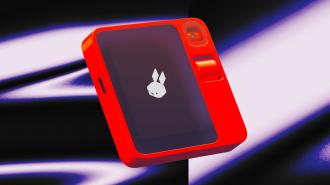Rabbit — an AI startup on a mission to create “the world’s simplest computer” — has just unveiled R1, so hyped, the first batch of devices sold out within 24 hours. People who were able to get their order in could be getting the first devices as soon as March.
The challenge: If someone told you “There’s an app for that” back in 2009, when Apple first debuted the slogan, you might have been pleasantly surprised and thanked them for the tip while navigating to the App Store.
Today, you might be more inclined to roll your eyes. Of course there’s an app for “that” — with more than 4 million apps available for download between the Apple’s App Store and Google’s Play Store, there’s an app for everything.
“We’ve come to a point where we have hundreds of apps on our smartphones with complicated UX designs that don’t talk to each other,” said Jesse Lyu, founder and CEO of Rabbit. “As a result, end users are frustrated with their devices and are often getting lost.”
“Our Large Action Model … generates actions on behalf of users to help us get things done.”
Jesse Lyu
The idea: Rabbit’s new AI-powered device, R1, is designed to free you from the hassle of navigating countless individual apps on your phone. Just tell the device what you want it to do — “Order an Uber to take me to work,” for example — and it’ll carry out the task.
“Large Language Models, like ChatGPT, showed the possibility of understanding natural language with AI,” said Lyu. “Our Large Action Model takes it one step further: it doesn’t just generate text in response to human input — it generates actions on behalf of users to help us get things done.”
How it works: The palm-sized R1 is bright orange-red with a touchscreen display taking up about 75% of its front. Next to the screen is an analog scroll wheel, and beside it, on the side of the device, is a button you hold when you want to talk to your R1.
Above the scroll wheel is a camera, called the “Rabbit Eye.” It can rotate 360 degrees, so you can turn it toward you for selfies or video calls and away from you to take pictures or videos. When not in use, you can face the camera up or down, essentially closing the “eye.”
“We never save your username and password, and we don’t track your data.”
Jesse Lyu
R1’s operating system, Rabbit OS, includes a web portal, the “Rabbit Hole,” where you can choose which popular apps, such as Uber, Spotify, and Amazon, you want to activate on the device after connecting it to Wi-Fi or a cell plan.
“We never save your username and password, and we don’t track your data,” said Lyu during a presentation at CES 2024. “The authentication happens on the respective apps.”
Once activated, you can simply tell your R1 what you want it to do through those services while holding the talk button — this action eliminates the need for the device to constantly listen in for you to say a “wake word.”
R1 isn’t limited to simple tasks on single apps, like calling Ubers, either — during the CES presentation, Lyu asked the device to plan a family trip to London, and it presented options for flights, hotels, car rentals, and more that he could book with a tap on the screen.
To train its Large Action Model to perform such tasks, Rabbit showed it how people use the apps currently accessible through the device. In the future, it plans to add a capability that would allow you to train the system yourself to use other apps, simply by pointing R1’s camera at your phone or laptop while you use them.
Looking ahead: R1 doesn’t seem designed to replace smartphones, and because there’s really nothing like it on the market right now, it’s hard to know just how many people would be willing to carry around a second device just to avoid completing tasks through individual apps.
However, Rabbit did sell all 10,000 units in its initial batch of devices within 24 hours of opening pre-orders on its website, suggesting there is a market for some kind of tech that solves this problem. Those R1s are expected to begin shipping in late March 2024, and the startup is now accepting orders for a second batch that will be delivered in April-May 2024.
We’d love to hear from you! If you have a comment about this article or if you have a tip for a future Freethink story, please email us at [email protected].






